Welcome back to another Dig Through Time—I apologize for the lateness of this article. I had some computer troubles, and some issues with work and getting ready for a second child. This week we're going to check out 2002's Onslaught set. Onslaught brought back the cycling mechanic which was first introduced during Urza's Saga, and which we saw most recently in Amonkhet block. Onslaught also brought in the keyword fear, which would later become evergreen for a time before being replaced by intimidate and ultimately menace. You almost certainly know some of the most popular cards from this set: Aggravated AssaultAggravated Assault, Akroma's VengeanceAkroma's Vengeance, Arcanis the OmnipotentArcanis the Omnipotent, and Blatant ThieveryBlatant Thievery, but what cards are hiding beneath the most obviously powerful cards in this set? Let's find out!
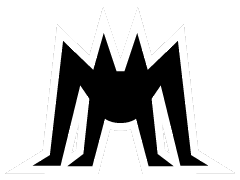
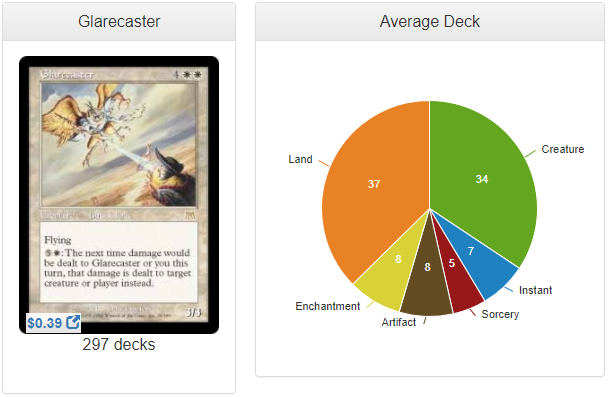
GlarecasterGlarecasteris a fantastic repeatable combat trick on a stick that sees play in 297 decks. Let's ignore the glaring mana costs and discuss the card's ability. Unlike Deflecting PalmDeflecting Palm and some other versions of this effect, Glarecaster doesn't prevent damage, it simply redirects it. That means that like Mirror StrikeMirror Strike and Reflect DamageReflect Damage, Glarecaster can send an opponent's commander damage back into their own face, and without even having to steal their commander!
Okay, now about that cost. Six mana to cast a 3/3 flier is a bit much, I'll admit. However, paying a fixed cost of six to redirect damage to another creature or player is actually really good. When I started building my Kynaios and Tiro of MeletisKynaios and Tiro of Meletis Aikido deck I had Captain's ManeuverCaptain's Maneuver and Divine DeflectionDivine Deflection (among other big X spells) in my decklist. It quickly became apparent that X costs were, well, costly. Some might say unwieldy. Using those fixed-cost spells like Deflecting PalmDeflecting Palm and Mirror StrikeMirror Strike was way better than casting a Divine Deflection. I could pay two, three, four or five mana to send 30 damage back in someone's face with those cards, instead of paying 30 plus a white for the same effect.
Glarecaster's activated ability costs six, but it's repeatable. If you're sending 21 damage from a Voltron commander at another player, you don't mind paying the six instead of 21, and as long as you can dodge removal, you know you can keep sending that damage at other players for the same cost each turn.

Kangee, Aerie KeeperKangee, Aerie Keeper plays this card the most at 87 decks, most likely for tribal synergies. As mentioned above, this is an ideal card for an Aikido deck. Queen MarchesaQueen Marchesa and Kynaios and Tiro of MeletisKynaios and Tiro of Meletis seem to be the most common commanders for this archetype; running cards like Deflecting PalmDeflecting Palm, Illusionist's GambitIllusionist's Gambit, Batwing BrumeBatwing Brume and Rakdos CharmRakdos Charm to deflect, reflect, and otherwise redirect damage toward more deserving targets. A big-mana deck in Selesnya or Bant colors helmed by someone like Derevi, Empyreal TacticianDerevi, Empyreal Tactician might work out well for activating Glarecaster multiple times per wheel of the table.
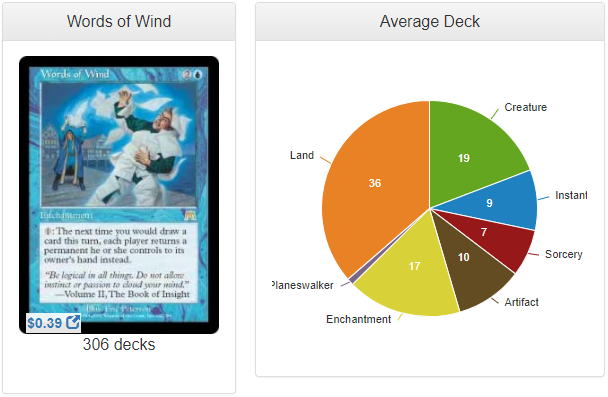
Words of WindWords of Wind is repeatable, symmetrical bounce that sees play in 306 decks. There are plenty of strategies that work well with bounce. One of the best is low converted mana cost creatures with enter the battlefield (ETB) triggers. Cards like Wall of OmensWall of Omens, Wall of BlossomsWall of Blossoms, Baleful StrixBaleful Strix and Elvish VisionaryElvish Visionary are particularly great because they're cheap, and the card draw effect on them can let you reuse Words of Wind immediately. If you can pay for it, Words of Wind and any of these creatures can bounce your opponents' whole boards to hand, lands and all, while leaving your board tapped out, but untouched.
Words of Wind also lets you reset hate cards like Pithing NeedlePithing Needle, Gideon's InterventionGideon's Intervention and Ixalan's BindingIxalan's Binding in case a tastier target comes along while also forcing your opponents to bounce a creature or a land or a sol ring each.
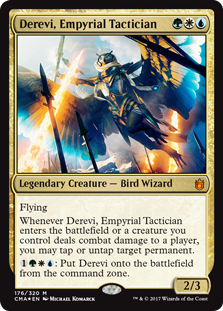
Derevi, Empyreal TacticianDerevi, Empyreal Tactician, who tends to run a pretty tricky, bouncy, stax-y sort of shell, plays this card the most at 22 decks. A quick note—this card shows up in six Kynaios and Tiro of MeletisKynaios and Tiro of Meletis decks, and that's a fine home for the card, but Words of Wind does not synergize with K&T themselves. If you skip the end of turn draw and pay one to make everyone bounce something, your opponents can just bounce a tapped land and then replay it untapped for free. Sen TripletsSen Triplets is also great with this card because they can cast the cards you force your opponents to bounce back to hand. Turns out, not enough Sen Triplets are playing bounce.
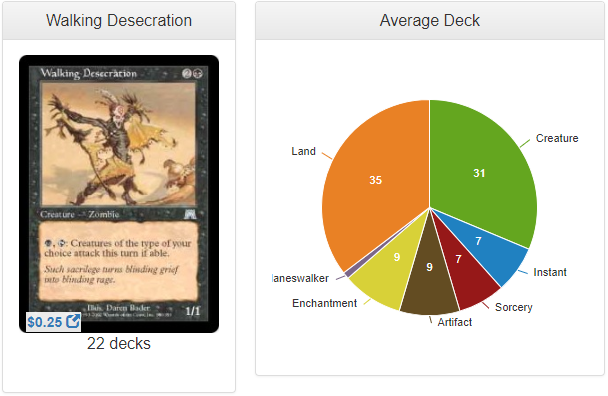
Seeing play in 22 decks, Walking DesecrationWalking Desecration lets you throw off one player's combat step each wheel of the table. This effect isn't unheard of, but it's not common in black, and it doesn't usually let you pick a certain creature type. Commander 2017 offers a unique opportunity, given that the four decks are tribal. Forcing the Edgar MarkovEdgar Markov player to attack with her Blood ArtistBlood Artist and Viscera SeerViscera Seer when she really doesn't want to can help you sculpt the battlefield the way you want. Running stuff like No MercyNo Mercy can ensure that the damage doesn't come your way.

Walking Desecration sees play in so few decks that it has no top commanders. I could see this fitting into a Queen MarchesaQueen Marchesa (Long may she reign!) deck that wants to screw with combat. Throw in GlarecasterGlarecaster, Rakdos CharmRakdos Charm, Batwing BrumeBatwing Brume, Marchesa's DecreeMarchesa's Decree and you're halfway there. Make your opponents beat each other up, but punish them for taking any swings at you. Teysa, Envoy of GhostsTeysa, Envoy of Ghosts is great for the same reason that this card synergizes with No MercyNo Mercy. Send those creatures swinging at someone else, or turn them into spirit tokens for you.

Head GamesHead Games is a fun reverse tutor that sees play in 378 decks. This card is just fun. Of course, there's the obvious scenario where an opponent has a hand of 10+ cards after resolving a Soul's MajestySoul's Majesty or something, and you make it a hand of 10+ lands. (Don't worry, friend, your deck is full of gas. I'm sure you'll draw into it now that I took all of those pesky lands out.) But don't overlook the possibility of collusion. Go find a much-needed board wipe or piece of spot removal and give it to the white player. Make sure the Yasova DragonclawYasova Dragonclaw player has a CounterspellCounterspell in hand. Find a CloneClone so you and Sedris the Traitor KingSedris the Traitor King both have a Mogis, God of SlaughterMogis, God of Slaughter to tax the rest of the table with.
The best course of action is usually to give your opponent one or two things that will be useful to you and replace the rest with junk. Of course, you can't be too obvious about it, because you might find that key card you gave them turned against you if the new hand is too bad.

Pseudo-MindslaverMindslavering an opponent each turn, Sen TripletsSen Triplets plays this card the most at 36 decks, and basically uses Head Games as a super Behold the BeyondBehold the Beyond. Dralnu, Lich LordDralnu, Lich Lord and Kess, Dissident MageKess, Dissident Mage can use and reuse it as targeted hand disruption. It could also see play in Kambal, Consul of AllocationKambal, Consul of Allocation, allowing him to fill an opponent's hand with inconsequential noncreature spells to drain the opponent.
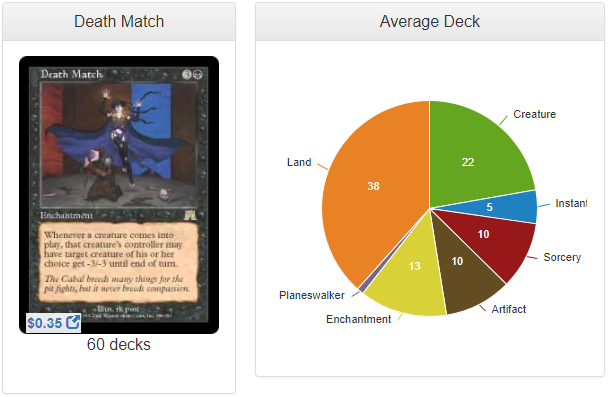
Death MatchDeath Match keeps the board free and clear of those pesky creatures your opponents keep trying to put out. The best decks to run this would be creatureless decks or token decks that pump out way more token creatures than your opponents can keep up with. Running this with cards like Fleshbag MarauderFleshbag Marauder, Merciless ExecutionerMerciless Executioner, Slum ReaperSlum Reaper, and Abyssal GatekeeperAbyssal Gatekeeper lets you get added value out of your symmetrical removal. This is also kind of hilarious in conjunction with Norin the WaryNorin the Wary.
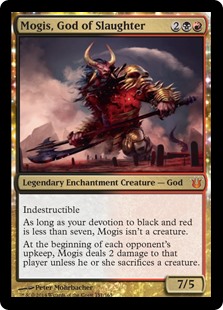
Death Match sees play in so few decks that it doesn't have a top commander. I think that Mogis, God of SlaughterMogis, God of Slaughter could pick this up as an extra hate card alongside Lethal VaporsLethal Vapors, Spreading PlagueSpreading Plague, and Tainted AetherTainted Aether. Edgar MarkovEdgar Markov swarms the board with tokens, allowing you to keep a few creatures ahead of your opponents at all times. Reanimation engines like Sedris, the Traitor KingSedris, the Traitor King and Sheoldred, Whispering OneSheoldred, Whispering One can keep the -3/-3 triggers coming, and are big enough that it's somewhat difficult for your opponents to turn the effect back on you.
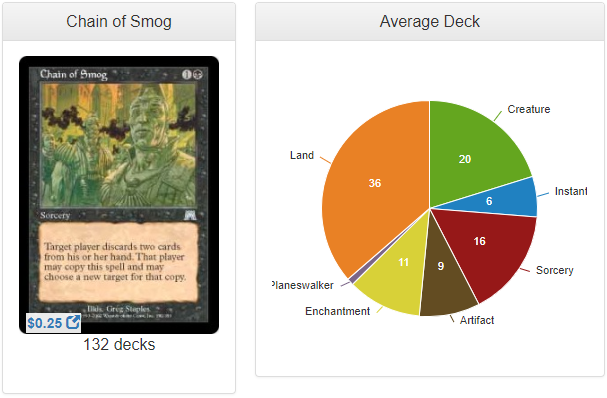
Chain of SmogChain of Smog is another political black card that sees play in 132 decks. You need an opponent to play along, but this card can potentially make everyone discard their whole hand. Cards like Geth's GrimoireGeth's Grimoire, Raiders' WakeRaiders' Wake, MegrimMegrim, Liliana's CaressLiliana's Caress, and Waste NotWaste Not can give you enough value out of this card that it doesn't really matter if your opponents do play along or not.
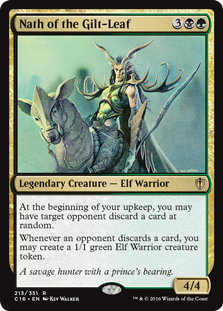
Nath of the Gilt-LeafNath of the Gilt-Leaf plays this card the most at 11 decks. This card is great in Kess, Dissident MageKess, Dissident Mage where you can store your hand in your graveyard and accrue long-term value that your opponents can't. Some Nekusar the MindrazerNekusar the Mindrazer decks run heavy discard themes, and this could pop up there as well.

Seeing play in 189 decks, Kaboom!Kaboom! is one of just two non-Un-cards that has an exclamation point in its name! (The other being To Arms!To Arms!.) It the right high-CMC deck this card is pretty good. If you're a bit of a Timmy like me, you want to run this with copying cards. Cards like Primal WellspringPrimal Wellspring, Pyromancer's GogglesPyromancer's Goggles, Swarm IntelligenceSwarm Intelligence, Increasing VengeanceIncreasing Vengeance make this card so much fun. And it gives you (even more) incentive to run giant spells like ExpropriateExpropriate.
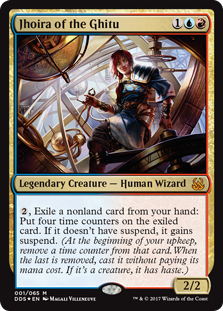
Jhoira of the GhituJhoira of the Ghitu, who loves to cheat high-CMC cards into play, runs this card the most at 15 decks. Vial Smasher the FierceVial Smasher the Fierce, and possibly your favorite partner of choice, get to stack some extra damage on your damage when you cast this first in a turn. Melek, Izzet ParagonMelek, Izzet Paragon is another spell doubler, but he also lets you peek at which card is coming up in case you have Kaboom! in hand. This card is also pretty good in Neheb, the EternalNeheb, the Eternal who can turn all of that damage into mana; against three opponents, you're almost guaranteed to get your mana back, and then some.

Butcher OrggButcher Orgg is a repeatable soft board wipe that sees play in 75 decks. His closest parallel is probably Lord of Shatterskull PassLord of Shatterskull Pass or Balefire DragonBalefire Dragon, but he works a little bit differently than either, kind of mixing in green's super trample ability from Thorn ElementalThorn Elemental. To take full advantage of his unique ability, you really want to beef this guy up and give him first strike, deathtouch, or, better yet, both. So, dig those Bloodmark MentorBloodmark Mentors and Basilisk CollarBasilisk Collars out of your collection and get ready to spread some aggro.
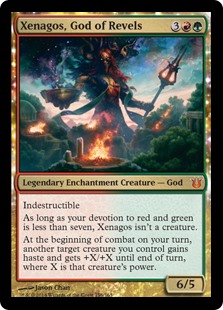
Xenagos, God of RevelsXenagos, God of Revels, who turns this guy into a 12/12 at the beginning of your combat, plays this card the most at 21 decks. Due to the expensive converted mana cost, you probably want to keep this in a deck running green so you can ramp into it quickly. Saskia the UnyieldingSaskia the Unyielding is a perfect candidate. She runs green for ramp, and she's all about combat all the time. Ruric Thar, the UnbowedRuric Thar, the Unbowed is another commander that might like to try running this Orgg, especially since it's tricky to run non-creature board wipes in Ruric Thar, and there aren't a whole lot of creatures that wipe the board.
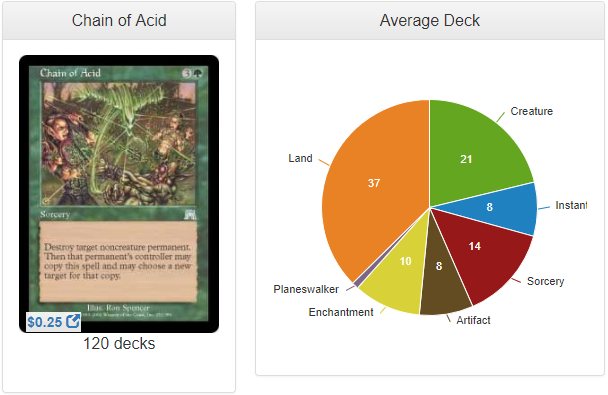
Use with extreme caution! Chain of AcidChain of Acid sees play in 120 decks, but, perhaps even more than the other cards in the Chain cycle, can really come back to bite you in the butt. Politically, it can be prudent to blow up Player A's inconsequential clue or treasure token, and then have Player A blow up Player B's PanharmoniconPanharmonicon or The ChainveilThe Chainveil. You've just achieved the effect you wanted, you got rid of the Panharmonicon, but you've also turned Player B against Player A instead of turning Player B against you by blowing up their important combo piece directly.
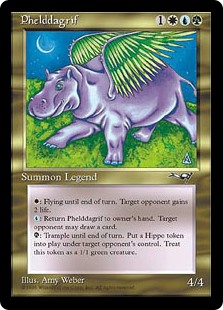
PhelddagrifPhelddagrif runs this card the most at eight decks. This card is goodstuff-y enough that any deck with green could run it, but something political like Kynaios and Tiro of MeletisKynaios and Tiro of Meletis, or Shizuko, Caller of AutumnShizuko, Caller of Autumn might like this for its interplayer implications. Commanders like Sakiko, Mother of SummerSakiko, Mother of Summer that would benefit from running ArmageddonArmageddon but can't due to color restrictions can turn this card into an approximation of mass land destruction, while leaving their creatures untouched.
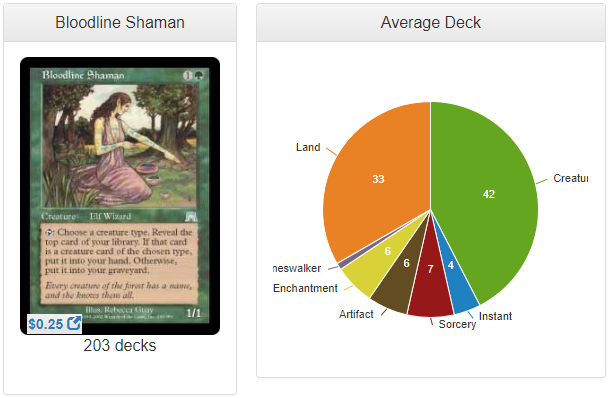
Bloodline ShamanBloodline Shaman is a decent tribal draw engine that sees play in 203 decks. This card recently got even better when Arcane AdaptationArcane Adaptation came out in Ixalan, and rounded out the tribal fixing enchantments ConspiracyConspiracy and XenograftXenograft. Obviously, you might end up dumping a land with this card, but once you hit a certain land density you really don't want any more lands. If you end up dumping a spell with this card, you may not have built the deck properly. As usual, cards that keep your top card revealed, or that let you look at your top card, like Oracle of Mul DayaOracle of Mul Daya, Future SightFuture Sight, and Vizier of the MenagerieVizier of the Menagerie give you perfect information so you never whiff. One nice thing about this card is that you can name a different creature type every time you activate it, just in case you need to switch it up.
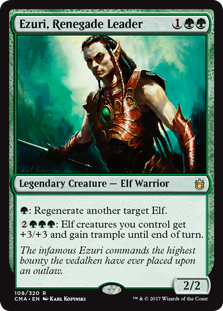
Elfball seems like a good place for this card, and—surprise, surprise—Ezuri, Renegade LeaderEzuri, Renegade Leader plays Bloodline Shaman the most at 48 decks. Other elf commanders that can use more draw include Freyalise, Llanowar's FuryFreyalise, Llanowar's Fury, Yeva, Nature's HeraldYeva, Nature's Herald, and Nissa, Vastwood SeerNissa, Vastwood Seer among others. Commanders like The MimeoplasmThe Mimeoplasm and Karador, Ghost ChieftainKarador, Ghost Chieftain are also fine homes for this card, as they don't really care so much if you draw the card or mill it.
The Action
You may have seen it coming, but this week's action segment is going to roll out an Aikido deck featuring Kynaios and Tiro of MeletisKynaios and Tiro of Meletis at the helm.
My own meta has lots of aggro players (this is uncommon, I hear), so I've cut down on a lot of the "creatures must attack each turn, if able" type effects. If you have a lot of shrinking violets in your meta, you may need to encourage them a little with some more cards like Fumiko the LowbloodFumiko the Lowblood and Warmonger HellkiteWarmonger Hellkite. Otherwise, the deck seeks to use an opponent's resources, specifically the damage that their creatures would be dealing to me, against them. The deck runs low on creatures overall but has no qualms about borrowing your opponents' from time to time. Generally, you don't want to remove any of your opponent's permanents unless they're threatening to combo out with those permanents, or they're inconveniencing you. The biggest thing to deal with is generally artifacts and enchantments, and you'll find that the deck packs a heavy removal package.
[Artifacts] *1 Sol Ring *1 Bident of Thassa [/Artifacts]
[Creatures] *1 Dulcet Sirens *1 Portal Mage *1 Goblin Spymaster *1 Aven Mindcensor *1 Selvala, Explorer Returned *1 Selfless Squire *1 Balduvian Warlord *1 Regal Behemoth *1 Glarecaster *1 Avatar of Slaughter [/Creatures]
[Enchantments] *1 Mass Hysteria *1 Rest in Peace *1 Sterling Grove *1 Ghostly Prison *1 Propaganda *1 Curse of Verbosity *1 Curse of the Nightly Hunt *1 Rites of Flourishing *1 Aura of Silence *1 Overabundance *1 War's Toll *1 Gideon's Intervention *1 Awakening *1 Bedlam *1 Sphere of Safety [/Enchantments]
[Instants] *1 Brainstorm *1 Swan Song *1 Wear // Tear *1 Delay *1 Arcane Denial *1 Reroute *1 Deflecting Palm *1 Mirror Strike *1 Riot Control *1 Boros Fury-Shield *1 Render Silent *1 Comeuppance *1 Return to Dust *1 Reins of Power *1 Illusionist's Gambit *1 Master Warcraft *1 Reflect Damage *1 Sylvan Reclamation [/Instants]
[Sorceries] *1 Ponder *1 Preordain *1 Vandalblast *1 Hull Breach *1 Clan Defiance *1 Search for Tomorrow *1 Spoils of Victory *1 Kodama's Reach *1 Council's Judgment *1 Tempt with Discovery *1 Skyshroud Claim *1 Disrupt Decorum *1 Chronomantic Escape *1 Descent of the Dragons *1 Hour of Revelation *1 Insurrection [/Sorceries]
[Lands] *1 Throne of the High City *1 Prairie Stream *1 Exotic Orchard *1 Forbidden Orchard *2 Mountain *3 Plains *5 Forest *3 Island *1 Breeding Pool *1 Canopy Vista *1 Cinder Glade *1 Stomping Ground *1 Temple Garden *1 Prahv, Spires of Order *1 Reliquary Tower *1 Sunhome, Fortress of the Legion *1 Glacial Fortress *1 Hinterland Harbor *1 Rootbound Crag *1 Sulfur Falls *1 Sunpetal Grove *1 Arid Mesa *1 Flooded Strand *1 Misty Rainforest *1 Windswept Heath *1 Wooded Foothills *1 Scalding Tarn *1 Field of Ruin *1 Alchemist's Refuge [/Lands] [/Deck]
Dean Gootee
Dean is a father, writer, and long-time fan of Magic and gaming in general. Currently located in Rochester, NY; he loves playing with new people, so if you're ever in the area, shoot him a message. Follow him on Twitter @GrubFellow, where he tweets #dailyEDH microcontent.
Your opinions are welcome. We love hearing what you think about Magic! We ask that you are always respectful when commenting. Please keep in mind how your comments could be interpreted by others. Personal attacks on our writers or other commenters will not be tolerated. Your comments may be removed if your language could be interpreted as aggressive or disrespectful. You may also be banned from writing further comments.
